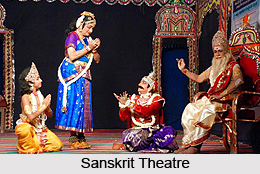 History of Sanskrit theatre is an inseparable part of Indian theatre. It also draws heavily from the Sanskrit literary tradition. The early Sanskrit theatrical plays were based on pre-existing mythological or historical themes that were familiar to the audience of the age. The nature of the plays ranged from tragedy to light comedy. Sanskrit theatre played a pivotal role in the development of Indian theatre.
History of Sanskrit theatre is an inseparable part of Indian theatre. It also draws heavily from the Sanskrit literary tradition. The early Sanskrit theatrical plays were based on pre-existing mythological or historical themes that were familiar to the audience of the age. The nature of the plays ranged from tragedy to light comedy. Sanskrit theatre played a pivotal role in the development of Indian theatre.
Lord Brahma the Creator, was approached by the gods to produce an object of sport i.e. kridaniyaka to give pleasure to people`s eyes and ears. Brahma took recourse to yoga, selected the text from the Rig Veda, song and music from the Sama Veda, acting from the Yajur Veda, and aesthetic sentiment from the Atharva Veda to create a fifth Veda. Now this fifth Veda is known as the natyaveda i.e. `theatre knowledge`. He also created tradition in the form of Itihasa, describing the exploits of gods, demigods, demons, and humans, on the basis of which dramatic scripts could be written. Brahma invited the gods to receive this unique creation, but they declined. The learned commentator on the Natyashastra named Abhinavagupta explains that they did so because they only knew happiness, whereas drama is the saga of happiness as well as suffering.
The gods called the sage Bharata, practicing penance and surrounded by his hundred sons and disciples, to receive this sacred art of theatre. Brahma commanded him to stage a play celebrating the victory of gods over demons. Bharata, along with his sons and pupils, rehearsed the play based on the legendary battle between gods and demons. Angry, the demons created trouble and obstacles, for example causing the loss of the performers` memory. The show failed. Then Brahma bade Visvakarman, the divine architect, to build an auditorium presided over by the gods, demigods, and even demons, thus a symbolic replica of the entire universe. The demons accepted this neutrality and the gods were overjoyed by the new creation. Lord Shiva contributed to theatre with the tandava dance expressing vigorous emotion, his spouse Parvati gave the tender and sensuous lasya dance, while Lord Vishnu was responsible for creating four styles or characteristics i.e. vritti essential to the effect of drama.
Bharata then brought this celestial art to earth. F. B. J. Kuiper reveals some interesting aspects in the structure of Sanskrit theatre. He draws attention to the cosmogonic battle between the gods and demons during which they not only employed normal weapons but also verbal combat. Unmistakably, all the essential elements of Sanskrit theatre are present in the Vedas, obviously derived from ancient Indian life. A number of hymns in the form of dialogue i.e. samvada sukta exist in the Rig Veda itself, expressively recognised as such by early Indian tradition.




